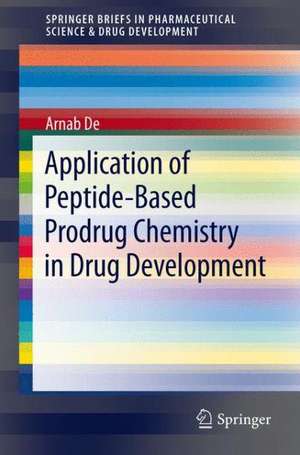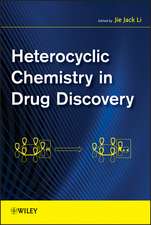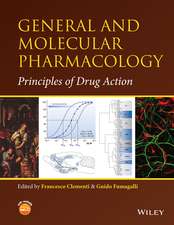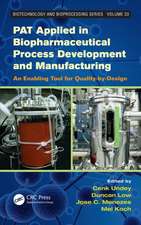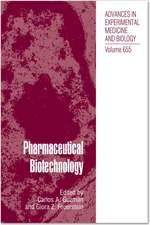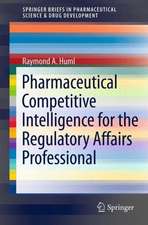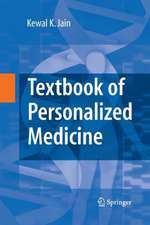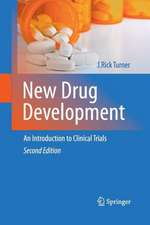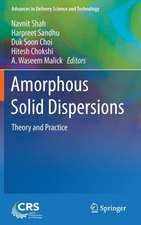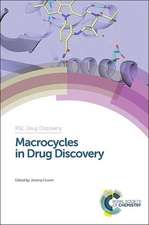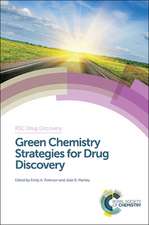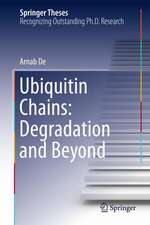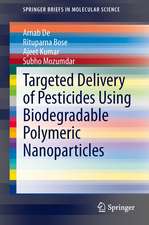Application of Peptide-Based Prodrug Chemistry in Drug Development: SpringerBriefs in Pharmaceutical Science & Drug Development
Autor Arnab Deen Limba Engleză Paperback – 18 aug 2012
In this volume, the use of novel therapeutics like GLP1 as an alternative to tradition insulin-based drugs in diabetes is described. Application of Peptide-Based Prodrug Chemistry in Drug Development elucidates the traditional concept of prodrugs as “specialized non-toxic protective groups used in a transient manner to alter or to eliminate certain limiting properties in the parent small molecule” (IUPAC definition). It goes on to provide insight into how prodrugs of peptides (with GLP1 as an example) could be appropriately used to extend the biological half life, broaden the therapeutic index of macromolecules and improve the pharmacodynamics of such drugs. Author explains the logic behind designing peptide prodrugs, synthetic procedures and bioassays to examine the conversion of the prodrug to the drug under therapeutic conditions. The prodrugs described slowly convert to the parent drug at physiological conditions of 37C and pH 7.2 driven by their inherent chemical instability without the need of any enzymatic cleavage. The diketopiperazine and diketomorpholine (DKP and DMP) strategies for prodrug conversion are demonstrated in detail with special emphasis on the chemical flexibility that it offers to develop prodrugs with variable time actions.
This book will be of usefulto chemists, biochemists, medicinal chemists, biologists and people in the medical profession (doctors). It may be used in undergraduate classes but will certainly help post-graduate students and advanced professionals.
The author is grateful to Prof. Richard DiMarchi (Standiford H. Cox Professor of Chemistry and the Linda & Jack Gill Chair in Biomolecular Sciences at Indiana University) for valuable suggestions. The foreword for the book has been written by Prof. Jean Martinez, (Legion d'Honneur awarded by the French Republic; Professor of Chemistry and Medicinal Chemistry of the University of Montpellier, France; and Chairman of European Peptide Society, 2002-2010).
Preț: 377.35 lei
Nou
Puncte Express: 566
Preț estimativ în valută:
72.23€ • 78.48$ • 60.71£
72.23€ • 78.48$ • 60.71£
Carte tipărită la comandă
Livrare economică 21 aprilie-05 mai
Preluare comenzi: 021 569.72.76
Specificații
ISBN-13: 9781461448747
ISBN-10: 1461448743
Pagini: 104
Ilustrații: XII, 89 p. 74 illus., 23 illus. in color.
Dimensiuni: 155 x 235 x 5 mm
Greutate: 0.16 kg
Ediția:2013
Editura: Springer
Colecția Springer
Seria SpringerBriefs in Pharmaceutical Science & Drug Development
Locul publicării:New York, NY, United States
ISBN-10: 1461448743
Pagini: 104
Ilustrații: XII, 89 p. 74 illus., 23 illus. in color.
Dimensiuni: 155 x 235 x 5 mm
Greutate: 0.16 kg
Ediția:2013
Editura: Springer
Colecția Springer
Seria SpringerBriefs in Pharmaceutical Science & Drug Development
Locul publicării:New York, NY, United States
Public țintă
ResearchCuprins
Macromolecular (specifically peptide-based) drugs could potentially be highly effective medicines. However they have a relatively short duration of action and variable therapeutic index. An example of such a peptide is Glucagon-like Peptide I which could potentially be used as a revolutionary drug for diabetes. This is because it stimulates insulin only when the blood glucose level is high thereby reducing the risk of hypoglycemia (a significant disadvantage of using insulin is that an insulin overdose is the single most potent cause of life-threatening hypoglycemia). However it’s short duration of action (half-life of 2 minutes in plasma) precludes its therapeutic use.
In this volume, the use of novel therapeutics like GLP1 as an alternative to tradition insulin-based drugs in diabetes is described. Application of Peptide-Based Prodrug Chemistry in Drug Development elucidates the traditional concept of prodrugs as “specialized non-toxic protective groups used in a transient manner to alter or to eliminate certain limiting properties in the parent small molecule” (IUPAC definition). It goes on to provide insight into how prodrugs of peptides (with GLP1 as an example) could be appropriately used to extend the biological half life, broaden the therapeutic index of macromolecules and improve the pharmacodynamics of such drugs. Author explains the logic behind designing peptide prodrugs, synthetic procedures and bioassays to examine the conversion of the prodrug to the drug under therapeutic conditions. The prodrugs described slowly convert to the parent drug at physiological conditions of 37C and pH 7.2 driven by their inherent chemical instability without the need of any enzymatic cleavage. The diketopiperazine and diketomorpholine (DKP and DMP) strategies for prodrug conversion are demonstrated in detail with special emphasis on the chemical flexibility that it offers to develop prodrugs with variable time actions.
This book will be of usefulto chemists, biochemists, medicinal chemists, biologists and people in the medical profession (doctors). It may be used in undergraduate classes but will certainly help post-graduate students and advanced professionals.
The author is grateful to Prof. Richard DiMarchi (Standiford H. Cox Professor of Chemistry and the Linda & Jack Gill Chair in Biomolecular Sciences at Indiana University) for valuable suggestions. The foreword for the book has been written by Prof. Jean Martinez, (Legion d'Honneur awarded by the French Republic; Professor of Chemistry and Medicinal Chemistry of the University of Montpellier, France; and Chairman of European Peptide Society, 2002-2010).
Table of contents:
Introduction.- Aapplication of Prodrug Chemistry to GLP-1.- Experimental procedures.- Characterization of Prodrugs.- Conclusion.
In this volume, the use of novel therapeutics like GLP1 as an alternative to tradition insulin-based drugs in diabetes is described. Application of Peptide-Based Prodrug Chemistry in Drug Development elucidates the traditional concept of prodrugs as “specialized non-toxic protective groups used in a transient manner to alter or to eliminate certain limiting properties in the parent small molecule” (IUPAC definition). It goes on to provide insight into how prodrugs of peptides (with GLP1 as an example) could be appropriately used to extend the biological half life, broaden the therapeutic index of macromolecules and improve the pharmacodynamics of such drugs. Author explains the logic behind designing peptide prodrugs, synthetic procedures and bioassays to examine the conversion of the prodrug to the drug under therapeutic conditions. The prodrugs described slowly convert to the parent drug at physiological conditions of 37C and pH 7.2 driven by their inherent chemical instability without the need of any enzymatic cleavage. The diketopiperazine and diketomorpholine (DKP and DMP) strategies for prodrug conversion are demonstrated in detail with special emphasis on the chemical flexibility that it offers to develop prodrugs with variable time actions.
This book will be of usefulto chemists, biochemists, medicinal chemists, biologists and people in the medical profession (doctors). It may be used in undergraduate classes but will certainly help post-graduate students and advanced professionals.
The author is grateful to Prof. Richard DiMarchi (Standiford H. Cox Professor of Chemistry and the Linda & Jack Gill Chair in Biomolecular Sciences at Indiana University) for valuable suggestions. The foreword for the book has been written by Prof. Jean Martinez, (Legion d'Honneur awarded by the French Republic; Professor of Chemistry and Medicinal Chemistry of the University of Montpellier, France; and Chairman of European Peptide Society, 2002-2010).
Table of contents:
Introduction.- Aapplication of Prodrug Chemistry to GLP-1.- Experimental procedures.- Characterization of Prodrugs.- Conclusion.
Notă biografică
Arnab De, M.A, M.Phil , is currently a PhD candidate at Columbia University Medical Center. He completed his undergraduate education in Presidency College, Calcutta, India before coming to the Unites States for his higher education. He came to Indiana University, Bloomington where he worked with Prof. Richard DiMarchi (Standiford H. Cox Professor of Chemistry and the Linda & Jack Gill Chair in Biomolecular Sciences) to develop peptide-based prodrugs as therapeutics for diabetes. The work with Prof. DiMarchi resulted in two patents (licensed by Marcadia Biotech, recently acquired by Roche) and multiple publications in peer reviewed journals. He presented his findings in the American Peptide Symposium’2009 and received the Young Investigator’s Award. He subsequently came to Columbia University where he is developing transgenic mice to serve as potential models for autoimmune diseases. He was invited by Carolyn J Honour (Editorial Director, Biomedicine at Springer) to write this bookin the Springer Brief series. The foreword has been written by Prof. Jean Martinez (Legion d'Honneur awarded by the French Republic and Chairman of European Peptide Society, 2002-2010).
Caracteristici
Explores a novel approach in designing prodrugs for macromolecules? Includes supplementary material: sn.pub/extras
